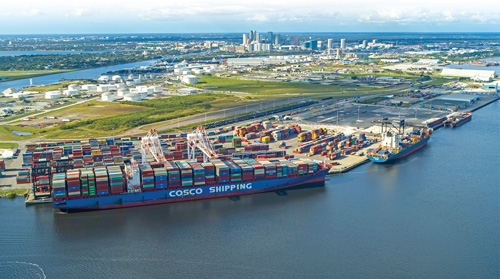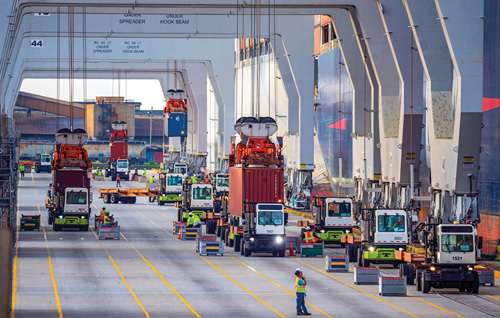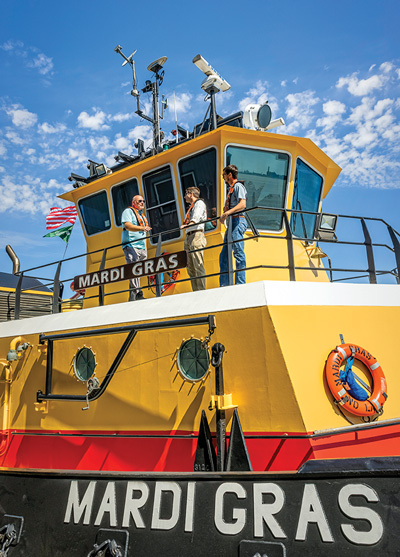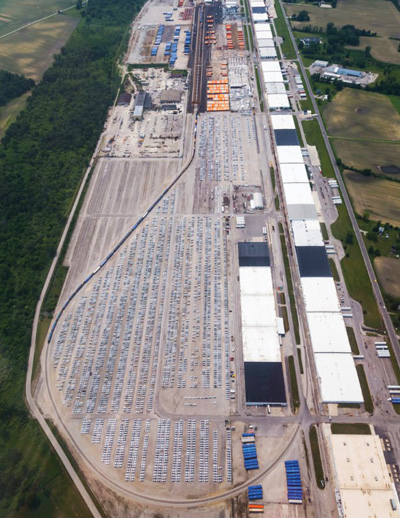By the BF Staff
From the January/February 2022 Issue
The pressure is on communities to provide as many intermodal services as possible as supplier demands for seamless transition intensifies.
The good news is that many regions of the country are responding, using the latest technologies and just plain old common sense to develop programs that will help get products to their final destination quickly and efficiently.
Of course, as supply chain issues during the COVID-19 pandemic have shown, more needs to be done. But many in the industry say that they have learned a lot about what they have accomplished thus far and what they need to do in the future to get ahead of the curve.
The industry is watching. Some ports, in particular, have done a strong job of furthering the interacton between various transportation modes; others are still struggling. The result, ultimately, will be the decision by some to use those venues that do the best job, saving time and money.

Port Tampa: Efficiency At Its Best
Port Tampa has global connections and no congestion. As shipping delays and congestion worsen elsewhere, emerging container ports, like Port Tampa Bay, stand ready to serve as supply chain solutions and alternatives. Port Tampa Bay is the largest and most diverse in the state of Florida and handles a wide variety of bulk, breakbulk, and containerized cargoes. Additionally, the port is a fuel energy gateway, a major cruise homeport, and a hub for shipbuilding and repair.
Port Tampa Bay proposes the most efficient way to move consumer goods through Florida, the Southeast region, and beyond needs to change. Florida is now the third most populated state in the nation, with more than 21 million residents and welcoming more than 100 million additional visitors every year. Florida also now has the 15th largest economy in the world. The importers and exporters who support this huge consumer market deserve a Florida First supply chain strategy with expanded direct ocean container services calling Florida ports directly, as opposed to the indirect routes via congested out-of-state ports, which is how much of this business, unfortunately, continues to move.
Throughout the pandemic, the demand for goods and imports continues to surge. The Tampa Bay region combined with the I-4 Corridor is home to almost half of Florida’s population. With more than 400 distribution centers, the I-4 Corridor is fueling demand for everything from retail and e-commerce goods, food & beverage, to energy products, and construction & building materials.
In March of 2021, the Port Tampa Bay Board of Commissioners approved an agreement with Celadon Development Corporation to lease 37 acres for the construction and operation of a paper fiber manufacturing plant. The public/private partnership will have significant economic and sustainability benefits, generating up to 20,000 export containers per year (40,000 TEUs), creating approximately 100 jobs, and involving a capital investment of $160 million during phase one of the project. The facility will receive and process mixed paper, corrugated cardboard, and plastic products sourced in Florida to produce paper fiber sheets for export to Asia. Environmental and sustainability benefits include increased recycling, water reuse, and reduction of greenhouse gases, saving over 1.8 million tons in carbon dioxide emissions. Phase Two of the project will see the addition of a second production line that will double the plant’s capacity, resulting in a total capital investment approaching $400 million.
Additionally, in July 2021, Port Tampa Bay welcomed the announcement by Dole Fresh Fruit, a subsidiary of Dole Food Company, to include Tampa in a new containerized service between Central America and the US Gulf. The US Gulf Express now includes a weekly direct call at Port Tampa Bay from Puerto Cortes and Puerto Castilla in Honduras, and Puerto Barrios, in Guatemala. In addition to Dole Fresh Fruit discharging bananas and pineapples at Port Tampa Bay, fixed weekly Full Container Load (FCL) containerized cargo service is offered through Dole’s commercial cargo division, Dole Ocean Cargo Express, LLC.
The new service is called the Gulf Express Service. Port Logistics Refrigerated Services (PLRS) provides terminal and stevedoring for the service at Port Tampa Bay. The PLRS terminal facility includes a new state-of-the-art 135,000 square foot cold storage warehouse, 148 reefer plugs, and fumigation services, as well as an adjacent berth served by two dedicated mobile harbor cranes.
Port Tampa Bay is in the midst of unprecedented growth in containers, now their fastest-growing line of business. This is a result of strategic investment and the attraction of new container services. Port Tampa Bay is not seeing any of the congestion or delays that have been creating issues for the other ports. Florida’s ports stand ready to welcome new business and serve as a supply chain alternative and solution. Port Tampa Bay’s container volume has increased by nearly 30% over the past year, and the port has easily accommodated this growth by staying ahead of the curve thanks to a terminal build-out program and working closely with terminal operator partner, Ports America.
Diversity is often a strength and ports that can bring in a variety of goods on a variety of ships, including breakbulk, multi-purpose, and small container ships will quicken supply chain efficiencies throughout the global market.
Port Tampa Bay’s proximity to the I-4 Corridor, home to the largest concentration of distribution centers in the state, allows for multiple round trip deliveries per day from Port Tampa Bay, compared to the traditional routes via congested out-of-state ports. This also reduces trucking costs and empty trucks on the road, 80 percent of which leave Florida empty. Improving trucking efficiencies has numerous economic and environmental benefits, eliminating the needless waste of fuel and reducing truck emissions. Additionally, Port Tampa Bay is well situated to solve other supply chain issues such as unloading the ships quickly and safely as they arrive at port, ensuring same-day delivery, and bypassing labor shortages, port congestion, and the rising cost of fuel.
Port Tampa Bay is in discussions with container lines about expanding their services to serve the growing Florida market. Eight of the top global container lines now offer weekly service from Asia to Port Tampa Bay. The recent addition of new weekly container connections with Mexico and expanded services with Latin America have added diversity and options.
Georgia Ports: Key To The Southeast
Efficient port services and a strategic location central to the U.S. Southeast make Georgia Ports an important factor in the location of industries involved in international trade.
The Port of Savannah provides fast access to 45 percent of U.S. consumers and manufacturers. Immediate links to I-16 (East/West) and I-95 (North/South) means key cities and manufacturing points throughout the U.S. Southeast may be reached within a one- to two-day drive. Daily rail departures via CSX and Norfolk Southern put inland destinations in easy reach.

Steady infrastructure investment increases Georgia Ports Authority’s capacity, allowing its deepwater ports to grow along with customer demand. Featuring 30 ship-to-shore cranes, 175 rubber-tired gantry cranes and nearly 10,000 feet of contiguous berth space, GPA’s Garden City Terminal is expanding to handle additional megaships.
In December, GPA brought online 400,000 TEUs of container handling space. By March 2022, another 500,000 TEUs will be added, growing to a total of 1.6 million of new capacity by June. The improvements will increase Savannah’s annual capacity by 25 percent.
GPA is also expediting completion of its Berth 1 expansion which will add one million TEUs of new berth capacity and eight ship-to-shore cranes. The project is now 30 percent complete and will come online in late spring 2023.
The Authority has completed and is now operating the second set of nine new tracks for a total of 18 tracks at its Mason Mega Rail Terminal. The expansion increases intermodal capacity to and from the Port of Savannah by more than 30 percent, for a total of 2 million TEUs per year in annual rail capacity.
Other expansion projects include:
Savannah Harbor deepening: A project of the U.S. Army Corps of Engineers, now 95 percent complete. The project should see substantial completion in January 2022. With a high-tide depth of 54 feet, the deeper harbor will allow vessels in the 16,000+ TEU range to take on heavier loads with fewer tidal restrictions.
25-acre chassis yard: Coming in March 2022, along Ga. 21.
Northeast Georgia Inland Port: Earthwork activities to begin early 2022. Completion is expected in mid- to late-2024.
Private Development: Private industry is also responding to the need for off-terminal infrastructure. Commercial real estate firms Colliers International and Cushman & Wakefield estimate 20 million square feet are under construction near the Port of Savannah. That constitutes a 25 percent increase over the current inventory of 80 million square feet of industrial space.
Beyond that, there is enough land permitted for private development for another 100 million square feet of industrial space within 30 miles of the port.
Recently, Amazon announced an expansion to its significant presence in Georgia with a new fulfillment center planned in Savannah. The 640,000-square-foot facility will feature innovative Amazon robotics technology and create 1,000 full-time jobs. The site is expected to open in 2022. Amazon currently employs more than 21,000 people in Georgia.
In another important development, the state of Georgia and the Savannah Harbor-Interstate 16 Corridor Joint Development Authority announced the purchase of a 2,284-acre economic development site. The Bryan County Mega-Site is strategically located adjacent to Interstate 16 with immediate access via I-95 and I-16 to 250 major metro areas, including Atlanta, Birmingham, Charlotte, Memphis and Orlando. The site is less than 30 miles from the Port of Savannah. Rail service to the site is provided by Georgia Central Railway, a short line railway that connects to CSX in Savannah and Norfolk Southern near Macon in Middle Georgia. Industrial utilities are adjacent to the site, and extensive due diligence reports have been completed to reduce barriers to speedy operations.
FTZ 104: Businesses conducting global trade via the Port of Savannah can also take advantage of the area’s status as a foreign trade zone. World Trade Center Savannah, grantee of FTZ 104, supports the FTZ program for Georgia businesses in a multi-county region near the Port of Savannah.
FTZs allow companies to source components from around the world at competitive prices, while keeping important value-added activities such as manufacturing in the U.S. Foreign and domestic merchandise can be admitted into a zone without formal Customs entry procedures, the payment of Custom duties or the payment of federal excise tax. The program is available to all U.S.-based companies and can be established in industrial parks, distribution centers and warehouse facilities. FTZs can be multi-user facilities or specific to one company’s use.
FTZ cost benefits include:
- Duty deferral: Customs duties deferred on imports improves cash flow.
- Duty elimination: No duty or quota charges on re-exports. No duty on waste, scrap or defective parts.
- Inverted tariff: Duty paid at the lower tariff rate of the imported component or finished product.
- Weekly entry: Reductions in merchandise processing fees due to weekly entry.
- Tax savings: Inventory may be exempt from local and state inventory taxes.
- Economic Driver Statewide: Georgia’s ports support nearly 500,000 full- and part-time jobs across the state, according to a study by the Selig Center for Economic Growth at the University of Georgia’s Terry College of Business.
The latest figure is based on Fiscal Year 2019 impacts, and represents an increase of 57,500 jobs (up 13 percent) compared to the previous report covering FY2017. Georgia ports now account for 10 percent of total state employment. Personal income derived from port-supported jobs totaled $29 billion statewide in FY2019.
Louisiana Offers An Unmatched Global Trade Solution
Business success often relies on infrastructure and logistics, and Louisiana’s extensive port system, proximity to the Gulf of Mexico and central location in the southern U.S. have established it as a powerful hub of global and domestic commerce.
The logistical advantages of doing business in Louisiana have put it at the epicenter of world trade for centuries. Thomas Jefferson recognized its unique geography, purchasing Louisiana from the French to facilitate shipping commerce from the Gulf of Mexico to the Midwest and America’s growing heartland.

Over time, Louisiana became a worldwide leader in exports of cotton, rice, soybeans and grain and imports of steel, rubber, coffee, fruits and vegetables.
Advancements aid Louisiana’s far-reaching ports: Location alone has not kept Louisiana on the forefront of international commerce, however. Evolving, adapting and expanding are also part of Louisiana’s logistics legacy, as evidenced by the creation of:
- Six Mississippi River deep draft ports, combining to handle the most domestic cargo in the nation.
- Six Class I railroads, spanning more than 3,000 miles. New Orleans is the only place in America where six Class I railroads converge with a deepwater seaport.
- More than 1,000 miles of interstate, connecting all corners of the state with major regional markets such as Atlanta, Dallas and Houston.
- Nearly 50,000 miles of pipelines, integrated to crisscross every major highway, railroad and navigable waterway in the state.
- Seven commercial airports, including Louis Armstrong International Airport, recently named North America’s No. 1 large airport by J.D. Power for customer satisfaction.
Louisiana Offshore Oil Port, the nation’s first and only deepwater oil port. Those long-term infrastructure investments are the reason Louisiana’s ports now carry 25 percent of all U.S. waterborne commerce, 60 percent of the nation’s grain and 20 percent of the nation’s coal. It’s also the reason Louisiana is home to five of the top 15 ports by tonnage in the U.S.
Louisiana’s cutting-edge logistics technology. The evolution and innovation continue. In 2021, a forward-thinking partnership between the U.S. Department of Commerce, the State of Louisiana and the nonprofit Water Institute of the Gulf developed the Lower Mississippi River SmartPort & Resilience Center, or SmartPort, to bring river navigation into the digital age.
Offering real-time data that can be shared by port administrators, shippers, tenants, cargo and ground transportation providers, SmartPort has been compared to the Waze motorist app, giving information that boosts efficiency by allowing users to assess critical operational factors such as tracking currents, river congestion, visibility and weather conditions.
SmartPort integrates crowd-sourced data from vessels traversing the region’s waterways with official survey data and artificial intelligence to develop accurate, immediate and actionable assessments of vital port and river conditions, including shoals, river depths, vessel congestion, visibility and other conditions. Its unique data-sharing solution enables the full spectrum of stakeholders—from captains to cargo companies and port operators—to pinpoint potential delays in operations and, in the process, significantly improve their logistical capabilities.
The contributions of SmartPort go beyond the day-to-day navigation of the river to encompass management of the river itself. Measuring sediment buildup is one of its most useful tools, providing real-time monitoring for dredging analysis.
Launch partners line up with Phase 2 plan in place. Eight Louisiana ports—Lake Providence, Madison, Vidalia, Baton Rouge, South Louisiana, New Orleans, St. Bernard and Plaquemines—have committed to being the first to deploy the SmartPort conditions assessment solution. The U. S. Department of Commerce, the State of Louisiana and other partners have pledged an additional $3 million combined to broaden the program’s reach by funding construction of a regional data sharing exchange and emergency operations center.
“Dynamic water levels, sedimentation, and reduced visibility are major challenges for ports all along the Mississippi River and beyond,” says Justin Ehrenwerth, the Water Institute’s president and CEO. “Leveraging existing technology and developing new predictive tools will allow us to address some of the most pressing challenges of today while anticipating those of tomorrow.”
Marion, Ohio: Preparing For The Future
Jaguar Transport Holdings, headquartered in Joplin, MO, acquired Marion Industrial Center on October 30, 2020. The 510-acre distribution and manufacturing facility in Marion, Ohio has been renamed Marion Industrial Rail Park to enhance the focus on the great rail infrastructure at the site.
The handling operations of the rail park are operated by Marion Logistics Services. This full-service 3PL operation handles the customer’s inbound and outbound product using barcode technology for inventory control. Marion team members take pride in being full-service while caring for their customers’ products. Marion Express, a trucking operation, is available onsite to fill trucking transportation needs for their customers.

Few communities in America can boast the rich heritage of Marion, a vibrant community best known as the home of Warren G. Harding, the nation’s 29th president. Among other notable residents are former Miss America Marilyn Meseke; agricultural industrialist Edward Huber, inventor of the revolving hay rake; and Mary Ellen Withrow, the first woman to serve as U.S. Treasurer.
Along with the Marion Industrial Rail Park, Marion’s manufacturing heritage includes specialized power shovels that were key to building the Panama Canal, as well as two customized crawlers for NASA that moved Apollo Mission Saturn V rockets to the launch pad that sent men to the moon. The crawlers, known as Hans and Franz, are still in use by NASA. Today, Marion is home to manufacturers such as Whirlpool, Nucor Steel, ArcelorMittal, Union Tank Car Co., Mennel Milling, Morral Companies, Piston Group, RobotWorx, Royal Group, Central Ohio Farmers Coop, Sakamura USA, Sims Brothers Recycling, US Yachiyo, Wilson Bohannan Lock Co., Silverline Windows, Sika, Wyandot Snacks and many others.
Marion and neighboring corn growers fuel America’s transportation with ethanol production by POET Biorefinery. Farming contributes about half of Marion County’s economic output.
As America’s Workforce Development Capital™, Marion, Ohio prepares tomorrow’s workforce through an educational corridor that includes The Ohio State University at Marion, Marion Technical College, Tri-Rivers Career Center/RAMTEC and Marion City and County School Districts. These entities serve as regional hubs for innovative and solution-oriented workforce education and training, and also partner with businesses through the Marion Area Workforce Acceleration Collaborative. The workforce development community operates as an integrated system to ensure that business and industry have access to the right talent, for the right job, at the right time.
Marion’s K-12 workforce development programs are innovative and exceptional. For example, Marion Harding became the first high school in Ohio to start a Global Logistics program in 2015. The entire two-year curriculum is project-based and addresses real-world logistics and supply chain scenarios. Students attend class for two periods each day where they research, write, discuss and create various presentations. At the completion of the program, students earn a Logistics Certification through MSSC and a Lean Six Sigma Yellow Belt Certification. Today, the program is looking to partner with Whirlpool Corporation once again to complete a Lean Six Sigma project of the organization’s choice.
It doesn’t end there. Tri-Rivers Career Center Robotics and Advanced Manufacturing Technology Education Center (RAMTEC) is a first of its kind in Ohio—and was recognized as one of the nation’s premier providers of robotics and advanced manufacturing industry certifications. At Marion Technical College, the rewarding of a National Science Foundation grant paved the way for the development of a Smart Manufacturing associate degree program.
Additionally, The Ohio State University at Marion has recently completed construction of a top-tier Science & Engineering Building, which operates in partnership with area industry to offer a Bachelor of Science in Engineering Technology.
OhioMeansJobs: Marion County is a comprehensive resource to existing and prospective companies as a full-service workforce center. Certified Business Engagement Professionals are available to tailor services and deliver results that are responsive to the specific needs of each business. Services are at no cost and include:
- Employee Recruitment
- Applicant Screening & Testing
- Targeted Advertising & Outreach
- Training Reimbursement for New Hires and Existing Employees
- Youth Workforce Programs
- Benchmarking Data
- Consultation & Research
- OhioMeansJobs Center, Marion, OH













![[VIDEO] Get More for Your Business in Ardmore. Oklahoma](https://businessfacilities.com/wp-content/uploads/2024/02/maxresdefault-324x160.jpg)
